Cheng Han
Resolving the Ambiguity of Complete-to-Partial Point Cloud Registration for Image-Guided Liver Surgery with Patches-to-Partial Matching
Dec 26, 2024Abstract:In image-guided liver surgery, the initial rigid alignment between preoperative and intraoperative data, often represented as point clouds, is crucial for providing sub-surface information from preoperative CT/MRI images to the surgeon during the procedure. Currently, this alignment is typically performed using semi-automatic methods, which, while effective to some extent, are prone to errors that demand manual correction. Point cloud correspondence-based registration methods are promising to serve as a fully automatic solution. However, they may struggle in scenarios with limited intraoperative surface visibility, a common challenge in liver surgery, particularly in laparoscopic procedures, which we refer to as complete-to-partial ambiguity. We first illustrate this ambiguity by evaluating the performance of state-of-the-art learning-based point cloud registration methods on our carefully constructed in silico and in vitro datasets. Then, we propose a patches-to-partial matching strategy as a plug-and-play module to resolve the ambiguity, which can be seamlessly integrated into learning-based registration methods without disrupting their end-to-end structure. It has proven effective and efficient in improving registration performance for cases with limited intraoperative visibility. The constructed benchmark and the proposed module establish a solid foundation for advancing applications of point cloud correspondence-based registration methods in image-guided liver surgery.
Exploring the Adversarial Vulnerabilities of Vision-Language-Action Models in Robotics
Nov 22, 2024



Abstract:Recently in robotics, Vision-Language-Action (VLA) models have emerged as a transformative approach, enabling robots to execute complex tasks by integrating visual and linguistic inputs within an end-to-end learning framework. While VLA models offer significant capabilities, they also introduce new attack surfaces, making them vulnerable to adversarial attacks. With these vulnerabilities largely unexplored, this paper systematically quantifies the robustness of VLA-based robotic systems. Recognizing the unique demands of robotic execution, our attack objectives target the inherent spatial and functional characteristics of robotic systems. In particular, we introduce an untargeted position-aware attack objective that leverages spatial foundations to destabilize robotic actions, and a targeted attack objective that manipulates the robotic trajectory. Additionally, we design an adversarial patch generation approach that places a small, colorful patch within the camera's view, effectively executing the attack in both digital and physical environments. Our evaluation reveals a marked degradation in task success rates, with up to a 100\% reduction across a suite of simulated robotic tasks, highlighting critical security gaps in current VLA architectures. By unveiling these vulnerabilities and proposing actionable evaluation metrics, this work advances both the understanding and enhancement of safety for VLA-based robotic systems, underscoring the necessity for developing robust defense strategies prior to physical-world deployments.
Visual Fourier Prompt Tuning
Nov 02, 2024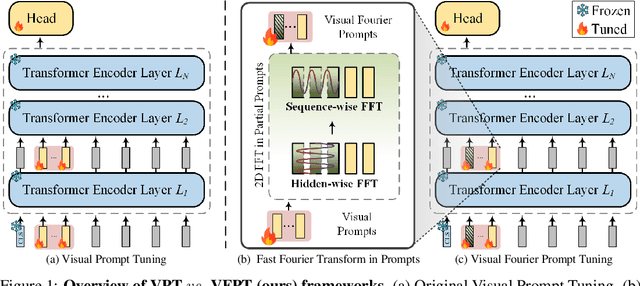

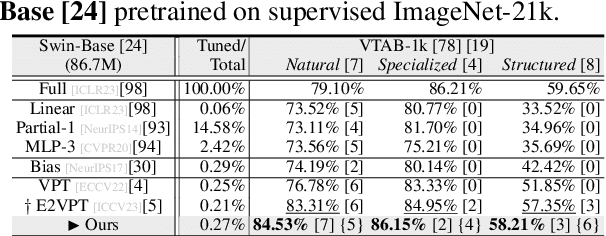
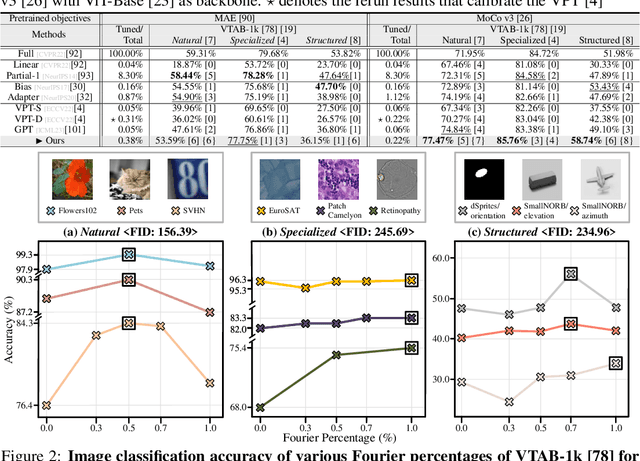
Abstract:With the scale of vision Transformer-based models continuing to grow, finetuning these large-scale pretrained models for new tasks has become increasingly parameter-intensive. Visual prompt tuning is introduced as a parameter-efficient finetuning (PEFT) method to this trend. Despite its successes, a notable research challenge persists within almost all PEFT approaches: significant performance degradation is observed when there is a substantial disparity between the datasets applied in pretraining and finetuning phases. To address this challenge, we draw inspiration from human visual cognition, and propose the Visual Fourier Prompt Tuning (VFPT) method as a general and effective solution for adapting large-scale transformer-based models. Our approach innovatively incorporates the Fast Fourier Transform into prompt embeddings and harmoniously considers both spatial and frequency domain information. Apart from its inherent simplicity and intuitiveness, VFPT exhibits superior performance across all datasets, offering a general solution to dataset challenges, irrespective of data disparities. Empirical results demonstrate that our approach outperforms current state-of-the-art baselines on two benchmarks, with low parameter usage (e.g., 0.57% of model parameters on VTAB-1k) and notable performance enhancements (e.g., 73.20% of mean accuracy on VTAB-1k). Our code is avaliable at https://github.com/runtsang/VFPT.
AMD: Automatic Multi-step Distillation of Large-scale Vision Models
Jul 05, 2024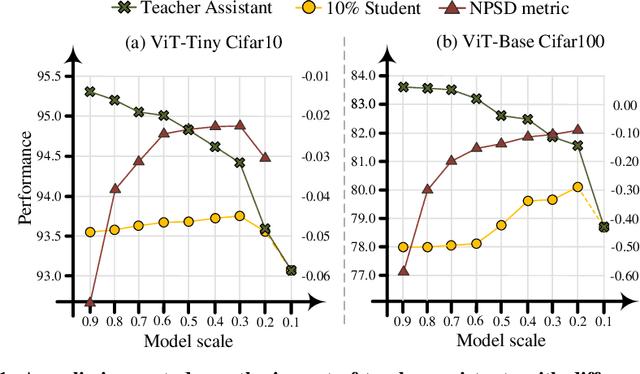

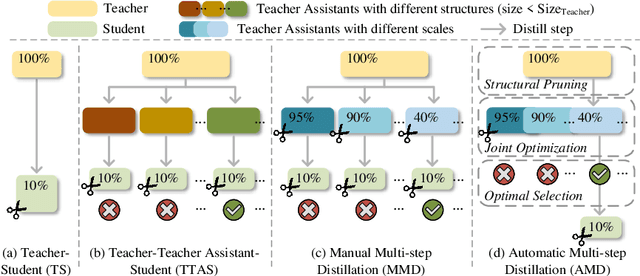

Abstract:Transformer-based architectures have become the de-facto standard models for diverse vision tasks owing to their superior performance. As the size of the models continues to scale up, model distillation becomes extremely important in various real applications, particularly on devices limited by computational resources. However, prevailing knowledge distillation methods exhibit diminished efficacy when confronted with a large capacity gap between the teacher and the student, e.g, 10x compression rate. In this paper, we present a novel approach named Automatic Multi-step Distillation (AMD) for large-scale vision model compression. In particular, our distillation process unfolds across multiple steps. Initially, the teacher undergoes distillation to form an intermediate teacher-assistant model, which is subsequently distilled further to the student. An efficient and effective optimization framework is introduced to automatically identify the optimal teacher-assistant that leads to the maximal student performance. We conduct extensive experiments on multiple image classification datasets, including CIFAR-10, CIFAR-100, and ImageNet. The findings consistently reveal that our approach outperforms several established baselines, paving a path for future knowledge distillation methods on large-scale vision models.
Self-supervised Adversarial Training of Monocular Depth Estimation against Physical-World Attacks
Jun 09, 2024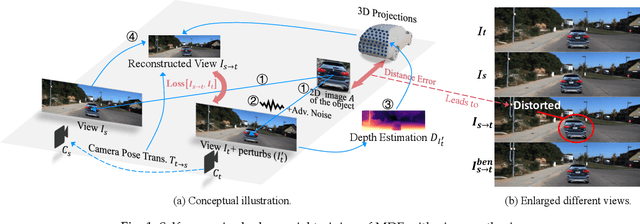

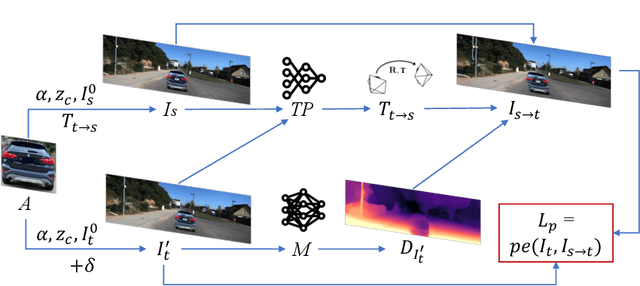
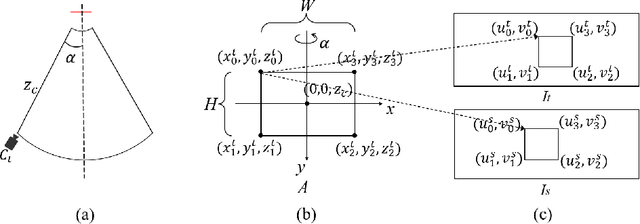
Abstract:Monocular Depth Estimation (MDE) plays a vital role in applications such as autonomous driving. However, various attacks target MDE models, with physical attacks posing significant threats to system security. Traditional adversarial training methods, which require ground-truth labels, are not directly applicable to MDE models that lack ground-truth depth. Some self-supervised model hardening techniques (e.g., contrastive learning) overlook the domain knowledge of MDE, resulting in suboptimal performance. In this work, we introduce a novel self-supervised adversarial training approach for MDE models, leveraging view synthesis without the need for ground-truth depth. We enhance adversarial robustness against real-world attacks by incorporating L_0-norm-bounded perturbation during training. We evaluate our method against supervised learning-based and contrastive learning-based approaches specifically designed for MDE. Our experiments with two representative MDE networks demonstrate improved robustness against various adversarial attacks, with minimal impact on benign performance.
ProMotion: Prototypes As Motion Learners
Jun 07, 2024

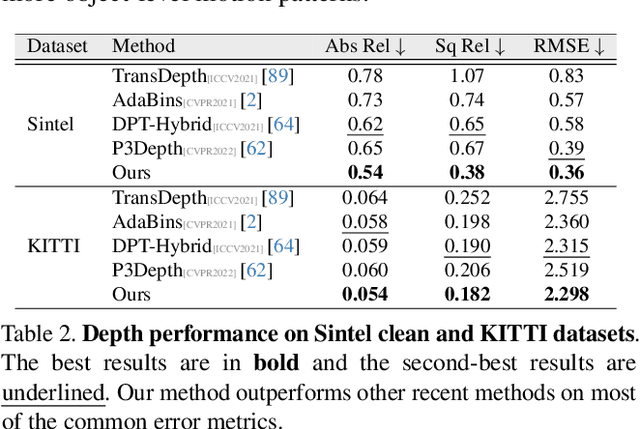

Abstract:In this work, we introduce ProMotion, a unified prototypical framework engineered to model fundamental motion tasks. ProMotion offers a range of compelling attributes that set it apart from current task-specific paradigms. We adopt a prototypical perspective, establishing a unified paradigm that harmonizes disparate motion learning approaches. This novel paradigm streamlines the architectural design, enabling the simultaneous assimilation of diverse motion information. We capitalize on a dual mechanism involving the feature denoiser and the prototypical learner to decipher the intricacies of motion. This approach effectively circumvents the pitfalls of ambiguity in pixel-wise feature matching, significantly bolstering the robustness of motion representation. We demonstrate a profound degree of transferability across distinct motion patterns. This inherent versatility reverberates robustly across a comprehensive spectrum of both 2D and 3D downstream tasks. Empirical results demonstrate that ProMotion outperforms various well-known specialized architectures, achieving 0.54 and 0.054 Abs Rel error on the Sintel and KITTI depth datasets, 1.04 and 2.01 average endpoint error on the clean and final pass of Sintel flow benchmark, and 4.30 F1-all error on the KITTI flow benchmark. For its efficacy, we hope our work can catalyze a paradigm shift in universal models in computer vision.
Prototypical Transformer as Unified Motion Learners
Jun 03, 2024
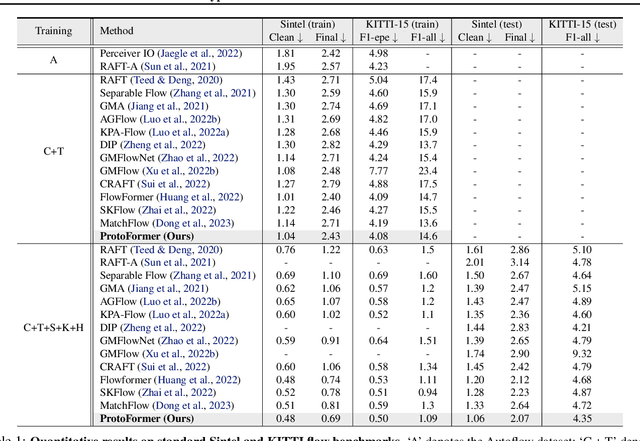
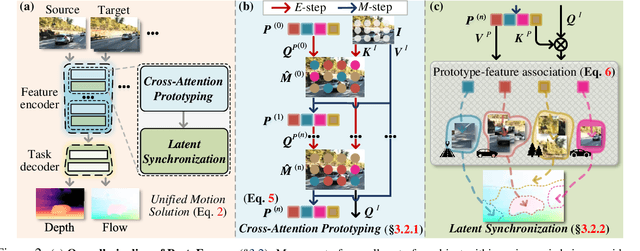
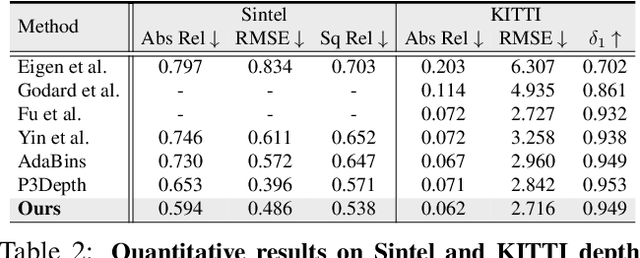
Abstract:In this work, we introduce the Prototypical Transformer (ProtoFormer), a general and unified framework that approaches various motion tasks from a prototype perspective. ProtoFormer seamlessly integrates prototype learning with Transformer by thoughtfully considering motion dynamics, introducing two innovative designs. First, Cross-Attention Prototyping discovers prototypes based on signature motion patterns, providing transparency in understanding motion scenes. Second, Latent Synchronization guides feature representation learning via prototypes, effectively mitigating the problem of motion uncertainty. Empirical results demonstrate that our approach achieves competitive performance on popular motion tasks such as optical flow and scene depth. Furthermore, it exhibits generality across various downstream tasks, including object tracking and video stabilization.
SSGA-Net: Stepwise Spatial Global-local Aggregation Networks for for Autonomous Driving
May 29, 2024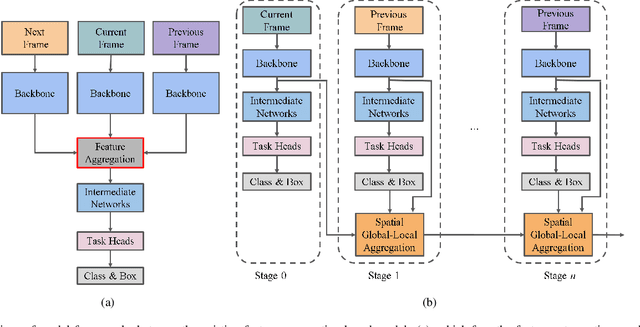
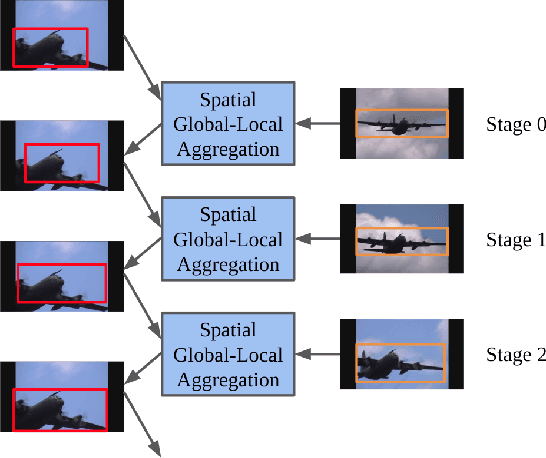
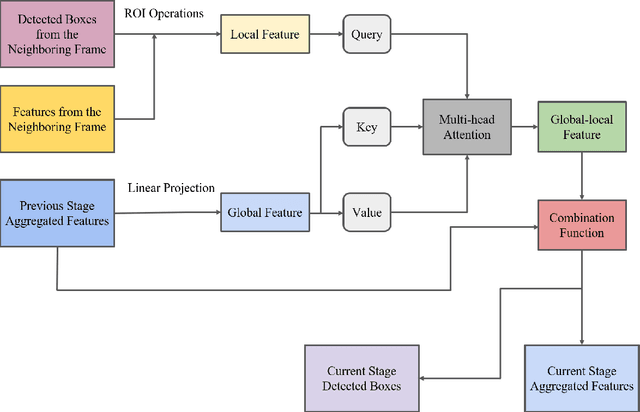
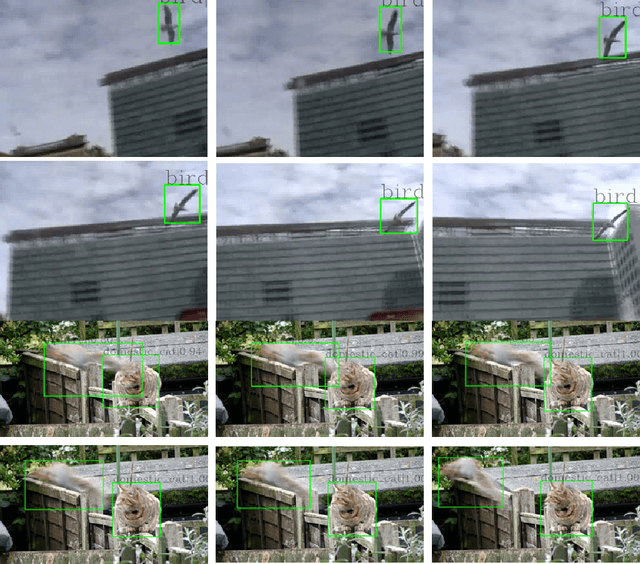
Abstract:Visual-based perception is the key module for autonomous driving. Among those visual perception tasks, video object detection is a primary yet challenging one because of feature degradation caused by fast motion or multiple poses. Current models usually aggregate features from the neighboring frames to enhance the object representations for the task heads to generate more accurate predictions. Though getting better performance, these methods rely on the information from the future frames and suffer from high computational complexity. Meanwhile, the aggregation process is not reconfigurable during the inference time. These issues make most of the existing models infeasible for online applications. To solve these problems, we introduce a stepwise spatial global-local aggregation network. Our proposed models mainly contain three parts: 1). Multi-stage stepwise network gradually refines the predictions and object representations from the previous stage; 2). Spatial global-local aggregation fuses the local information from the neighboring frames and global semantics from the current frame to eliminate the feature degradation; 3). Dynamic aggregation strategy stops the aggregation process early based on the refinement results to remove redundancy and improve efficiency. Extensive experiments on the ImageNet VID benchmark validate the effectiveness and efficiency of our proposed models.
Image Translation as Diffusion Visual Programmers
Jan 30, 2024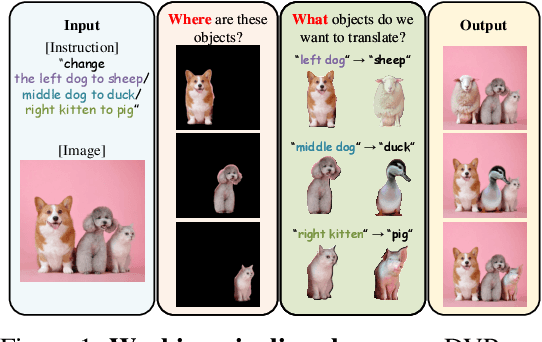



Abstract:We introduce the novel Diffusion Visual Programmer (DVP), a neuro-symbolic image translation framework. Our proposed DVP seamlessly embeds a condition-flexible diffusion model within the GPT architecture, orchestrating a coherent sequence of visual programs (i.e., computer vision models) for various pro-symbolic steps, which span RoI identification, style transfer, and position manipulation, facilitating transparent and controllable image translation processes. Extensive experiments demonstrate DVP's remarkable performance, surpassing concurrent arts. This success can be attributed to several key features of DVP: First, DVP achieves condition-flexible translation via instance normalization, enabling the model to eliminate sensitivity caused by the manual guidance and optimally focus on textual descriptions for high-quality content generation. Second, the framework enhances in-context reasoning by deciphering intricate high-dimensional concepts in feature spaces into more accessible low-dimensional symbols (e.g., [Prompt], [RoI object]), allowing for localized, context-free editing while maintaining overall coherence. Last but not least, DVP improves systemic controllability and explainability by offering explicit symbolic representations at each programming stage, empowering users to intuitively interpret and modify results. Our research marks a substantial step towards harmonizing artificial image translation processes with cognitive intelligence, promising broader applications.
Facing the Elephant in the Room: Visual Prompt Tuning or Full Finetuning?
Jan 23, 2024Abstract:As the scale of vision models continues to grow, the emergence of Visual Prompt Tuning (VPT) as a parameter-efficient transfer learning technique has gained attention due to its superior performance compared to traditional full-finetuning. However, the conditions favoring VPT (the ``when") and the underlying rationale (the ``why") remain unclear. In this paper, we conduct a comprehensive analysis across 19 distinct datasets and tasks. To understand the ``when" aspect, we identify the scenarios where VPT proves favorable by two dimensions: task objectives and data distributions. We find that VPT is preferrable when there is 1) a substantial disparity between the original and the downstream task objectives (e.g., transitioning from classification to counting), or 2) a similarity in data distributions between the two tasks (e.g., both involve natural images). In exploring the ``why" dimension, our results indicate VPT's success cannot be attributed solely to overfitting and optimization considerations. The unique way VPT preserves original features and adds parameters appears to be a pivotal factor. Our study provides insights into VPT's mechanisms, and offers guidance for its optimal utilization.
 Add to Chrome
Add to Chrome Add to Firefox
Add to Firefox Add to Edge
Add to Edge